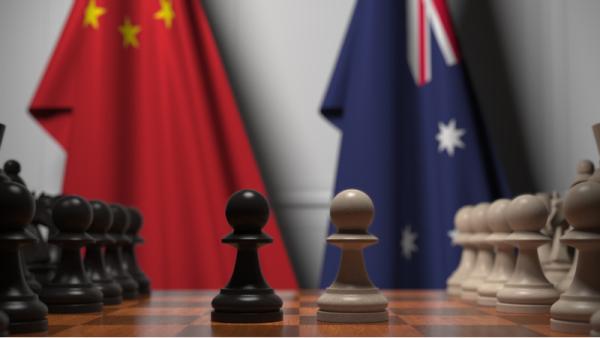Novikov Aleksey / Shutterstock

Elena Collinson, Senior Project and Research Officer, Australia-China Relations Institute, University of Technology Sydney |
This article appeared in the Australian Institute of International Affairs’ blog, Australian Outlook, on May 17 2022.
With the Australian federal election campaign in its final week, China policy remains a focal issue. This is amplified by the recently inked security agreement between Honiara and Beijing that potentially paves the way for China’s first military base in the Pacific.
The opposition, initially forced on the defensive by a government that had sought to portray them as weak on China and national security and who had repeatedly branded them ‘appeasers,’ have taken the opportunity to pivot, attacking the government for what Shadow Foreign Minister Penny Wong branded ’the worst Australian foreign policy blunder in the Pacific since the end of World War Two.’
The Australian public, however, are not particularly compelled by the denunciations on either side. A recent survey by the Australia-China Relations Institute at the University of Technology Sydney shows that the Australian public is evenly split in determining which political party is best placed to manage Australia’s China policy. Thirty-six percent nominated the Coalition, while 35 percent selected the Labor Party.
Indeed, there is near total political bipartisanship on China policy substance, a consensus the Coalition government and the opposition carried into the campaign. Both parties have definitively labelled Beijing’s trade sanctions against Australia ‘economic coercion,’ supporting the diversification of Australian exports away from exposure to China, and have effectively stated that any Australian consideration of China’s bid to enter the Comprehensive and Progressive Agreement for Trans-Pacific Partnership (CPTPP) will only follow the cessation of Beijing’s trade punishment against Australia, as well as the resumption of high-level dialogue between the two countries. Both have pledged an increase in defence spending, committing to take Australia’s defence budget to over two percent of GDP. The opposition have also made it clear that a Labor government would maintain engagement with the Quad and the AUKUS trilateral security partnership, continue Australia’s present stance on the South China Sea, and refrain from participation in the Belt and Road Initiative.
Prior to the campaign this bipartisanship had been acknowledged – and lauded – by the government. Following the announcement of AUKUS in September 2021, Prime Minister Scott Morrison thanked the opposition leader for ‘the bipartisan approach the opposition has taken in this vital national endeavour.’ Earlier that year, Defence Minister Peter Dutton acknowledged the Labor Party’s support for the government’s decision to cancel Victoria’s agreements with the China on the Belt and Road Initiative. And in 2020, Liberal backbencher James Paterson placed on the record his ‘appreciation for the offer of bipartisan support’ for the passing of the Foreign Relations Bill.
Despite the reinvigorated rhetorical duelling over the last few months, the continuation of this consensus was reflected in the foreign affairs debate between Foreign Minister Marise Payne and the shadow foreign minister on 13 May. Both were in lockstep when enunciating views on China. Made plain during the exchange was the jettisoning of the Howard-era formulation that Australia doesn’t need to choose between the US as its main ally and China as its main trading partner. Wong was particularly forthright, saying, ‘We have already chosen,’ explaining that ‘the way in which economic powers [are] utilised for strategic purposes means that duality… is no longer the case.’
Although not as definitive, a similar perspective is also becoming evident in the views of the Australian public. The UTS:ACRI/BIDA Poll 2022 reveals that of the four in ten Australians who said that China policy would factor into their decision-making process at the polling booth on 21 May, most were motivated by significant alarm over Beijing’s behaviour and perceived intent. Topping the list of concerns were Beijing’s willingness to use its trade and investment ties with Australia to punish the country over political disagreements (84 percent), and foreign interference by the Chinese state (81 percent).
It also shows that 73 percent of Australians agree that ‘China is a security threat,’ a six-point increase from 2021. The most striking jump in opinion in this year’s survey as compared with 2021 was in relation to support for Australian engagement in military conflict should Taiwan become a military flashpoint, especially if the US is involved. In the event of war between the US and China over Taiwan, 42 percent of Australians say that ‘Australia should remain neutral.’ This is an 11-point decrease from 2021. More than half of Australians (56 percent) say that in this scenario ‘Australia should lend military support to the United States,’ 11 points up from 2021. The hardening here is significant and appears to give the lie to the other results where there is a studied attachment to the old formula of maintaining a balance between the US and China.
Divergence between the two major parties is apparent with respect to the manner in which policies are to be effected. The Labor Party has undertaken to elevate diplomacy and ‘ensure a more central role for foreign policy in the content and implementation of strategy’ should it assume office. It will also buttress its China policy with a seven-point plan to ‘build a stronger Pacific family‘ and a commitment to deepen engagement with Southeast Asia, through commitments which include $470 million in foreign aid over four years and the appointment of an ASEAN special envoy, as well as the establishment of an office for the region in the Department of Foreign Affairs and Trade. The opposition has also continued to eschew the ideological framework the prime minister last year started to construct around his worldview – strident talk of liberal democracies versus authoritarianism and of the emergence of an ‘arc of autocracy‘ to ‘challenge and reset the world order in their own image’ remains absent from Labor’s foreign policy vision.
A change of government and the rhetorical modulation that it promises may afford some opportunity to place the Australia-China relationship on less adversarial footing. However, the toughening core of bilateral relations will likely continue, as the current China consensus in Australian politics faces pressure from global currents, as as-yet-unknowns such as developments in the Pacific continue to unfold, and from domestic currents, as public anxieties grow.
Author
Elena Collinson is a senior researcher at the Australia-China Relations Institute, University of Technology Sydney.


